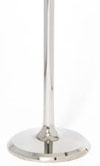Improving Surface Finish
 In the last article on the subject of surface finish, we looked at some of the important reasons for providing a good level of surface finish. On surfaces involved in sliding contact we can help to ensure that the lubricant film maintained by the basic geometry of the components and their motion is thick enough to keep the high-points or asperities of the two surfaces apart by providing a smoother surface with less peaks, and also peaks which are of a lower height. We also noted that the basic endurance limit of a material is increased by having a good surface finish on the part in question. As engines undergo a large number of operating cycles quickly during their intended lives, anything that we can do to increase the endurance limit of the material can only be a good thing. In doing so we allow ourselves either a greater-than-normal factor of safety against failure by fatigue, or to design parts to having our preferred factor of safety, but which are lighter and just as durable as a consequence of this increased endurance limit.
In the last article on the subject of surface finish, we looked at some of the important reasons for providing a good level of surface finish. On surfaces involved in sliding contact we can help to ensure that the lubricant film maintained by the basic geometry of the components and their motion is thick enough to keep the high-points or asperities of the two surfaces apart by providing a smoother surface with less peaks, and also peaks which are of a lower height. We also noted that the basic endurance limit of a material is increased by having a good surface finish on the part in question. As engines undergo a large number of operating cycles quickly during their intended lives, anything that we can do to increase the endurance limit of the material can only be a good thing. In doing so we allow ourselves either a greater-than-normal factor of safety against failure by fatigue, or to design parts to having our preferred factor of safety, but which are lighter and just as durable as a consequence of this increased endurance limit.
The author has recently been discussing surface finishing with a specialist in the field that provides a sub-contract service to improve surface finishes on components for various industries and recently exhibited at the Autosport Engineering show in the UK. Jon Porter of First Surface Limited explained that for the same reason that racing engineers are keen on the prospect of increased component life, it isn't universally popular with companies who make consumable parts for other industries. Cutting tools are an obvious example where revenues have been cut because the recent advantages in tool finishing and coating have made the tools last several times longer. Incidentally, using this process, it is claimed that it is possible to polish the thin-film coatings which are applied both to metal-cutting tools and racing components, many of which are only microns thick.
What should be clear to us, concerning any process of surface finish improvement, is that most of these will require some material removal, however minimal this is and that this must be accounted for in the design of the component, just as we would with a component finished by grinding etc. The amount of material removal is proportional to the level of surface finish provided on the component before undergoing the treatment, with finer pre-treatment surface finishes requiring less material removal to bring them to the desired finish. It was suggested in our discussion that the material removal required in taking a typical 0.8Ra turned finish and reducing it to 0.05Ra would be in the region of 5-10 microns per surface.
The surface finish treatment provided by the company above is claimed to be suitable for all types of metallic material and finish, including hardened and coated parts. Cams and followers would seem an obvious application where this might be employed, but given the advantages that we have seen can be brought about by having improved surface finish, it is likely that such processes could be used to advantage in a number of applications in the racing engine. Valves are another application, and the picture here is of a Formula One valve, treated by this process prior to use in an engine.
Fig. 1 - This F1 valve was polished before use in an engine (Courtesy First Surface)
Written by Wayne Ward